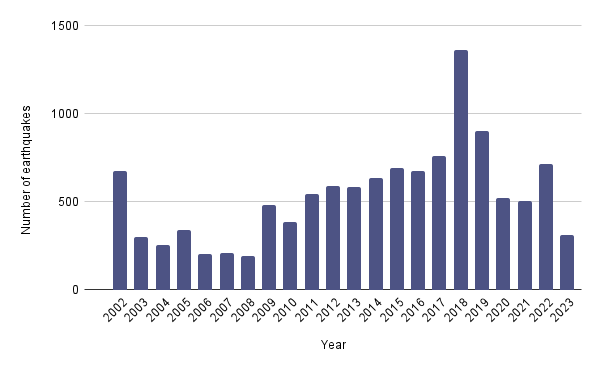
What is an earthquake?
Earthquakes are the sudden shaking and vibrating of the Earth’s crust due to a rapid release of energy when rocks break and move along faults.
The Earth's outer layer is made up of seven large separate tectonic plates, with an average thickness of 100km. These plates are constantly moving, at different speeds and in different directions. When the stress caused by the moving plates gets too large, the rocks break and slip past each other releasing energy into the crust in the form of vibrations, which we feel as earthquakes.
Australia’s tectonic plate is moving northwards at a rate of 7cm per year, while the Pacific Plate is moving west at nearly 9cm per year.
Earthquake data
Geoscience is the leading data source in Australia for data on earthquakes and seismic activity. It’s the trusted advisor on Australia’s geology and geography, applying science and technology to describe and understand the Earth.
Geoscience Australia has a dedicated website for , which shows the latest earthquake information from the National Earthquake Alerts Centre (NEAC) on an interactive map.
The Geoscience Australia also has a wealth of data available within the geophysics area of the portal. The interactive map can be used to highlight a range of layers or options from the site.
with overlay of earthquakes over the past 10 years
Are earthquakes on the rise in Australia?
Earthquakes are a common occurrence throughout Australia. We used Geoscience Australia’s earthquake to select a date range and download the data as a CSV. Below you can see a chart showing the number of earthquakes in Australia from 2002 to 2023.
Number of earthquakes from 2002 to 2023

The graph shows no visible trend over time — earthquakes are not on the rise in Australia. In fact, while the number of earthquakes did seem to be on the incline from 2006 to 2018, the figures dropped again in 2020 and 2021.
Over the past 11 years, 2018 is the outlier, with over 1,300 earthquakes. This compares to other years that are closer to 500-600 earthquakes per year.
When was the last earthquake in Australia?
From the data available from Geoscience , in the past 7 days Australia has experienced 7 earthquakes, including 2 that were off the coast. The largest of these 7 quakes was 3.2 in Port Macdonnell, SA.
The 7 earthquakes can be seen on this map of Australia, which is a screenshot taken from on 22 August 2023.
Want more Australian earthquake data?
In addition to Geoscience Australia, there are other organisations that keep seismic data. For example, the Seismology Research operates a private earthquake observatory network. It also runs the greatest number of earthquake seismograph stations in Australia. This data is not publicly available, however you can see details of the most recent .
Research Data provides data for research from over 100 Australian research organisations, government agencies and cultural institutions. It’s the data discovery service of the Australian Research Data (ARDC). Some of the sources of data available come from:
State government open data
For a more detailed look at specific states in Australia, see the open data available from the following state and federal open data portals:
- — thousands of datasets available for earthquake and seismic activity
- — 18 datasets tagged with ‘earthquake’ and 649 tagged with ‘seismic’
- QLD Open Data — access to all geoscience data by filtering on ‘ geoscience’, with 1357 datasets tagged with ‘seismic’.
- — over 15K state datasets with approximately 30 tagged with seismic or earthquake
- — approximately 20 datasets available using advanced search
- NT Open Data — show the NT statewide seismic
- Data — 12 datasets available for seismic activity
Australian university geological departments
Many Australian universities in Australia have departments providing a wealth of data. A couple of key examples are:
- University of Queensland — The UQ Seismological operates a network of seismographs in South East Queensland providing all the data available since June 2004.
- University of Melbourne — Research results from the School of Geography Earth and Atmospheric Sciences from a number of seismic monitoring
Global seismic data
If you’re interested in data from other parts of the world, you may like to check out these:
- — New Zealand’s greatest source of data (New Zealand lies across the Pacific-Australian Plate boundary and receives high seismic activity)
- The World Bank Data — The World Bank shares knowledge through its data catalogue of over 6000 datasets, including 100 earthquake-related datasets.
- Earthquake and Earthquake — provide global earthquake info and data
- The US Geological Survey — provides an array of earth, water, biological and mapping data
- — provides open data on a range of datasets published by the British Geological Survey (BGS)
- The International Seismological Centre — provides the ISC Bulletin, which contains data collected by seismological agencies from around the world, from 1900 to the present day.


